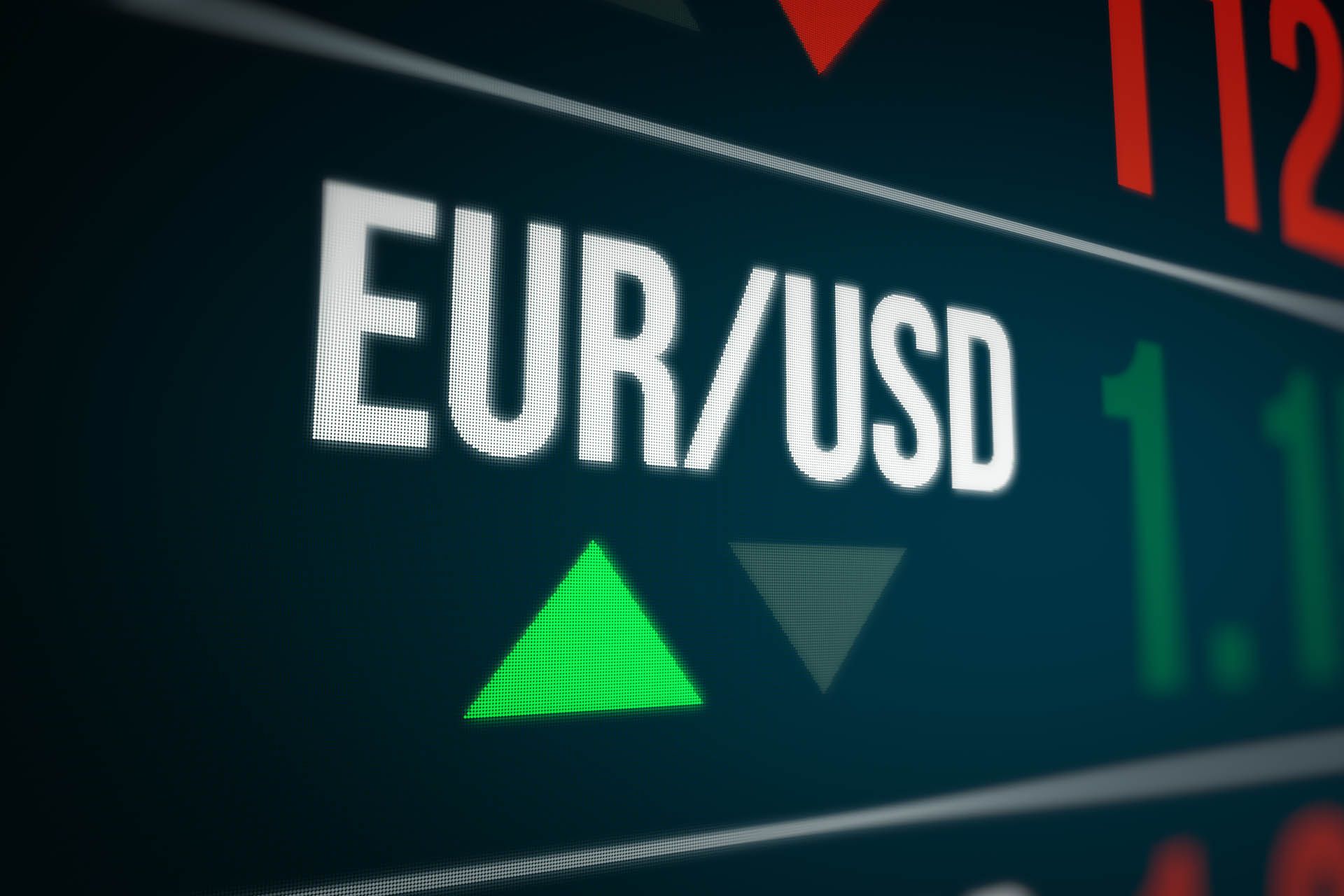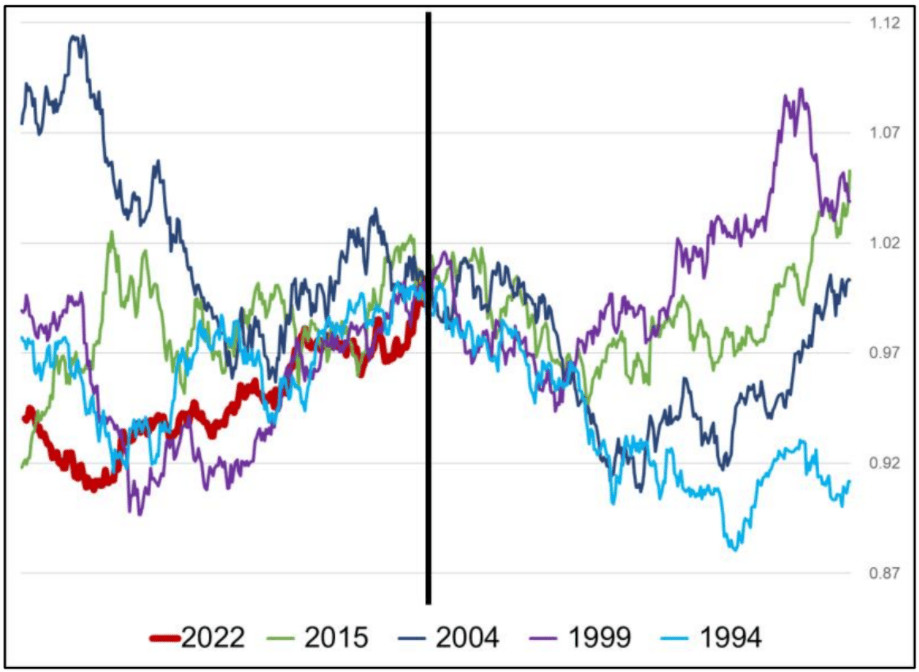Euro / Dollar 'Notably' Undervalued, Fed Rate Hike Could Help Close the Gap
- Written by: Gary Howes
-
- EUR/USD undervalued shows analysis
- EUR better supported on Ukraine headlines
- Fed to hike rates Wednesday
- USD tends to underperform following first hike

Image © Adobe Images
The Dollar traditionally tends to lose value after the Federal Reserve initiates its first rate hike of the cycle show studies, which could help an under pressure Euro to Dollar exchange rate recover.
This is because the Fed's watermark rate hike comes amidst elevated geopolitical tensions caused by the Ukraine war, which simply means this time is different to the times before.
"There is notable value in the EUR if one assumes geopolitical tensions are set to ease. EUR-USD is trading well below the levels implied by the rate differential (2Y 1M for example, a gap that could be ascribed to political risk," says Daragh Maher, Head of Research, Americas, at HSBC.
Above: "EUR-USD looks low relative to rate differentials" - HSBC.
The Euro was one of the major losers when Russia invaded Ukraine and sent European gas prices surging, but the initial shock of the invasion does appear to have now largely been absorbed by financial markets.
Of course the war is brutal and unpredictable and it is too soon to make any concrete calls as a result.
"The euro’s failure to hold on to initial gains likely reflects in part that the negative risk premium priced into the euro from the Ukraine conflict remains the main driver of performance in the near-term. Unless there is clear evidence that the Ukraine conflict is de-escalating the euro will struggle to stage a sustained rebound," says Lee Hardman, Currency Analyst at MUFG.
Ukraine and Russia continue to negotiate and at the time of writing we note some positive noises: "Volodymyr Zelensky says Russian peace talks sound more realistic," reports the Telegraph.
And in a nod to Russian demands Zelensky has said it is highly unlikely his country will join NATO, fulfilling a key Russian demand.
The Euro-Dollar exchange rate could recover further if markets factor the worst of the current episode has passed.
Market attention will almost certainly turn back to the issue of Federal Reserve rate hikes were Ukraine to become less of a pressing issue.
Indeed, today represents a significant milestone for global markets as the Federal Reserve will raise interest rates and signal the start of its normalisation process, but it will be the guidance on the outlook that will have the most impact on the Dollar.
- EUR/USD reference rates at publication:
Spot: 1.0980 - High street bank rates (indicative band): 1.0596-1.0672
- Payment specialist rates (indicative band): 1.0880-1.0903
- Find out more about market-beating rates and service, here
- Set up an exchange rate alert, here
The decision to raise rates by 25 basis points and associated guidance will come at 18:00 GMT, from when volatility in Dollar exchange rates might spike.
The market has been prepared for a 25 point hike for some time now and therefore this in itself is unlikely to shake the tree.
Already this week the yield on U.S. ten year bonds pushed back to its highest level since July 2019, and U.S. interest rate futures now have 175bp of tightening priced in this year compared to 120bp two weeks’ ago.
How the dial on future hikes moves will most likely be where the interest for foreign exchange markets lies.
"For this Wednesday, if we don’t see the dots reflect at least 5 hikes for this year, I suspect that the USD gets hit," says Bipan Rai, North America Head of FX Strategy at CIBC Capital Markets.
The 'dots' he refers to is the set of projections each voting member of the Federal Open Market Committee (FOMC) plots for where they see the base rate band being in the future.
Above: "FOMC participants’ assessments of appropriate monetary policy: Mid point of target range or target level for the federal funds rate" - Source: Federal Reserve.
Secure a retail exchange rate that is between 3-5% stronger than offered by leading banks, learn more.
If the dots move higher the market will accordingly price in more rate hikes, and this could boost the Dollar.
But the outlook is already richly priced and some foreign exchange strategists are unsure the Fed can really get much more 'hawkish', potentially leaving Dollar exchange rates exposed to a downside reaction.
"The market will be eyeing the dots. And those WILL need to shift from what was conveyed in December (3 hikes by the end of 2022, 3 for 2023 and 2 for 2024). The market is pricing in over 6 for this year, followed by 1-2 for next year," says Rai.
Brent Donnelly, CEO of Spectra Markets, says he looks to sell the Dollar on the first rate hike.
Donnelly, a market veteran who previously traded FX for HSBC, says "history says sell USD on the first Fed rate hike. It’s a sample size of four, so clearly not a statistical truth or anything, but logical. It is classic 'buy the rumor / sell the fact'."
Above: The Dollar index 250 days before and 250 days after the first Fed hike. - Spectra Markets.
And another chart Donnelly uses suggests heading into the first rate hike of 2022 shows the Dollar displaying very similar patterns to previous events:
Above: The same chart as above, but this time averaged. It shows a similar pattern is underway in 2022. Image: Spectra Markets.
Ahead of the FOMC event the Euro to Dollar exchange rate is seen trading at 1.0977, near its lowest levels since November 2020 and extending a medium-term downtrend that has been entrenched since May 2021.
The market has pushed the Euro lower against the Dollar largely in anticipation of a rapid series of rate hikes from the Federal Reserve that will certainly come faster than those delivered by the European Central Bank.
However, this theme has been in place for some time and is well understood by the market.
Euro bulls will therefore hope that the momentous occasion of the first Fed hike of the next cycle is where a material change in Euro-Dollar's fortunes lies.
Derek Halpenny, Head of Research at MUFG, has also identified the historic trend for the Dollar to fall following the first rate hike, but he warns this time could be different.
He says the strong momentum for the U.S. dollar into this first rate increase reflects the Russia’s invasion of Ukraine.
"It implies an element of difference in terms of comparisons with the previous rate hike cycles and therefore it suggests the scope for the US dollar to probably remain supported for longer than in the three previous cycles illustrated below," says Halpenny.













